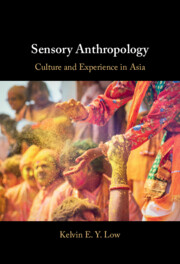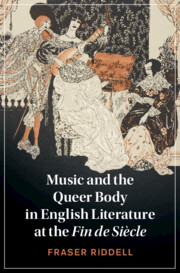50 results
Concluding Thoughts
-
- Book:
- Minoan Zoomorphic Culture
- Published online:
- 17 May 2024
- Print publication:
- 06 June 2024, pp 372-379
-
- Chapter
- Export citation
One - Life among the Animalian in Bronze Age Crete and the Southern Aegean
-
- Book:
- Minoan Zoomorphic Culture
- Published online:
- 17 May 2024
- Print publication:
- 06 June 2024, pp 1-37
-
- Chapter
- Export citation
Chapter 8 - Finding Your Happy Place in Solitude
-
- Book:
- Solitude
- Published online:
- 24 March 2024
- Print publication:
- 18 April 2024, pp 158-177
-
- Chapter
- Export citation
Introduction - Experiencing Rituals
-
-
- Book:
- Senses, Cognition, and Ritual Experience in the Roman World
- Published online:
- 04 January 2024
- Print publication:
- 25 January 2024, pp 1-26
-
- Chapter
- Export citation
4 - Sensing the Mission
-
- Book:
- The Mizo Discovery of the British Raj
- Published online:
- 12 October 2023
- Print publication:
- 02 November 2023, pp 147-171
-
- Chapter
- Export citation
29 - Liturgical Modes of Knowing: Coming to Know God (and Oneself) in Sixth-Century Hymns and Homilies
-
-
- Book:
- The Intellectual World of Late Antique Christianity
- Published online:
- 05 October 2023
- Print publication:
- 26 October 2023, pp 548-568
-
- Chapter
- Export citation
Chapter 3 - Experiencing the Casino
-
- Book:
- Luck, Leisure, and the Casino in Nineteenth-Century Europe
- Published online:
- 24 August 2023
- Print publication:
- 07 September 2023, pp 47-88
-
- Chapter
- Export citation
Chapter 1 - Odd Men Out
-
- Book:
- Lucretius and the End of Masculinity
- Published online:
- 11 May 2023
- Print publication:
- 25 May 2023, pp 1-34
-
- Chapter
- Export citation
Chapter 3 - Nature’s Assault upon the Senses
-
- Book:
- Lucretius and the End of Masculinity
- Published online:
- 11 May 2023
- Print publication:
- 25 May 2023, pp 57-82
-
- Chapter
- Export citation
8 - Political Confection
- from Part III - The Acting President
-
- Book:
- The Making Sense of Politics, Media, and Law
- Published online:
- 06 April 2023
- Print publication:
- 13 April 2023, pp 163-182
-
- Chapter
-
- You have access
- Open access
- HTML
- Export citation
Introduction
-
- Book:
- Sexual Restraint and Aesthetic Experience in Victorian Literary Decadence
- Published online:
- 02 March 2023
- Print publication:
- 09 March 2023, pp 1-31
-
- Chapter
- Export citation

Sensory Anthropology
- Culture and Experience in Asia
-
- Published online:
- 02 March 2023
- Print publication:
- 09 March 2023
3 - Defense of the Desire to Be Dead
-
- Book:
- Plato's <I>Phaedo</I>
- Published online:
- 02 February 2023
- Print publication:
- 09 February 2023, pp 54-87
-
- Chapter
- Export citation
1 - Now You Are Two: the End of the Beginning?
-
- Book:
- What Makes a Person?
- Published online:
- 03 November 2022
- Print publication:
- 03 November 2022, pp 1-37
-
- Chapter
- Export citation
Chapter 8 - Walls and the Ancient Greek Ritual Experience
- from Part IV - Materiality
-
-
- Book:
- Cognitive Approaches to Ancient Religious Experience
- Published online:
- 28 July 2022
- Print publication:
- 11 August 2022, pp 193-217
-
- Chapter
- Export citation
A didactic model to support the use of senses and sensors in environmental education problem solving
-
- Journal:
- Australian Journal of Environmental Education / Volume 39 / Issue 1 / March 2023
- Published online by Cambridge University Press:
- 22 June 2022, pp. 108-124
-
- Article
-
- You have access
- Open access
- HTML
- Export citation
2 - Unstable Instruments
-
- Book:
- Science on the Roof of the World
- Published online:
- 28 April 2022
- Print publication:
- 12 May 2022, pp 64-95
-
- Chapter
- Export citation
Chapter 4 - Touch: Transmission, Contact, Connection
-
- Book:
- Music and the Queer Body in English Literature at the Fin de Siècle
- Published online:
- 15 April 2022
- Print publication:
- 14 April 2022, pp 138-174
-
- Chapter
-
- You have access
- Open access
- HTML
- Export citation

Music and the Queer Body in English Literature at the Fin de Siècle
-
- Published online:
- 15 April 2022
- Print publication:
- 14 April 2022
-
- Book
-
- You have access
- Open access
- Export citation
Chapter 6 - Aquinas on ‘spiritual change’ in perception
- from Part I - Ontology and epistemology
-
- Book:
- Explorations in Ancient and Modern Philosophy
- Published online:
- 24 March 2022
- Print publication:
- 31 March 2022, pp 213-234
-
- Chapter
- Export citation



